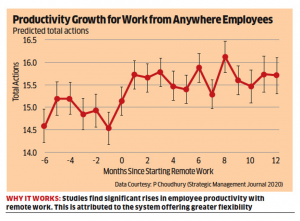
Since the Covid-19 pandemic broke out two years back, the world of work underwent significant changes. There were work stoppages, particularly in the manufacturing sector. The primary sector was the least affected. Service sector activities mostly shifted to work from home (WFH) mode, particularly activities that use information technology. As Covid-19 restrictions are eased, the physical workspace is still not fully utilised as a significant segment of the workforce are availing WFH. There are certain benefits of WFH that establishments are not ready to give up completely. It seems that hybrid work mode, a combination of physical and online, is here to stay.
This leads to an important question. Do companies really need the entire workforce to be in offices to get work done? Can the workplace be anywhere? If this question was asked in pre-pandemic times, it would have seemed irrelevant. But this question is relevant in the present context. Working from home and remote work have become popular in the post-Covid period. They offer significant cost savings as well as enormous flexibility. The concept of remote work is expanding its scope to include work from anywhere operations.

The concept of anywhere operations encapsulates several tools and technologies together such as remote access, visual collaboration, organisation management, data sharing and virtual meeting. Some organisations took anywhere operations to the next level by integrating virtual reality and augmented reality into their remote workflow, enabling them to manage businesses even more efficiently. The scale of the anywhere operations model depends on several factors including the nature and size of the establishments and the intensity of information technology use.
READ I Labour market: Concerns over informalisation of workforce
History of remote work
The phenomenon of remote work existed even before the Covid-19 pandemic. During the oil shock in the 1970s, several companies adopted remote work. But large-scale implementation happened in 2012 when the US federal government across departments — including agriculture, NASA and the US Patent Office — allowed remote work for employees.
Some organisations had already adopted this system when the pandemic struck. These included the US Patent and Trademark Office and some cutting-edge remote start-ups. All the pandemic did is hasten this phenomenon by about 10 years. The acceptance of remote work by several companies globally is one of the few good things in an otherwise hard time. Work from anywhere now applies across industries, from technology to banking, finance, and even industrial companies handling manufacturing and supply chains.
READ I ‘India’s unemployment crisis an opportunity to create an economic miracle’
Work from home increases productivity
Remote work statistics in 2021 show that a large number of organisations are showing an inclination toward hiring employees remotely. Employees are also benefitting in the process as it broadens livelihood opportunities and provides flexibility. The work from anywhere trend is reshaping the way organisations think and make important decisions, and it allows for a major paradigm shift from offices spanning multiple floors to a single-story office with a handful of essential employees. There is data proving that productivity increases with the increase in the volume of remote work.

Benefits for employees, companies
The greatest benefit for the employee is that it provides more freedom or temporal flexibility. Employees need not commute to offices, they can work at any time at their convenience. It provides spatial flexibility in the sense that it gives choice in relocating the place of residence. Many employees may not want to live in a big city. They might opt to live in small towns, and closer to their parents. People can save more if they move to a smaller town or they can choose to move to a better climate or a culturally preferred location.
A company with remote work can hire talent globally. Recruitment options increase manifold. The work from anywhere arrangement allows organisations to hire remote employees. Since organisations are not limited by geographical or demographic barriers, they can hire employees from any part of the world. It also allows organisations to scout for talent in the entire global labour market space. Remote employees used to be hired on a contractual or part-time basis, but now they are hired full-time.
Challenges to work from anywhere
Although it looks like a win-win situation, there are still challenges in shifting the company’s operations from an office-based environment to a work from anywhere model.
One possibility that remains distinct is that employees may end up working much longer than the standard working hours. Another challenge faced by both companies and employees is managing work across multiple time zones. This can make things difficult, especially if the time zones are scattered.
There are cyber security issues too. Many employees who are working remotely for the first time do not know the same best practices experienced remote workers know well, such as using a VPN on public networks, or not saving confidential information on their personal devices. Negligent workers are the most common cause for cyber security breaches and the risk increases exponentially in work from anywhere mode.
There are also questions about whether remote work leads to a blurring of work and leisure times. In other words, work-life imbalances may creep in as remote work has the potential of spilling over into personal space. Also, there are discussions about employees missing the socialisation opportunities physical work provides.
Challenges to remote work
There are many ways you can resolve the challenges arising from the work from anywhere model. The best way to manage organisational communication effectively is to integrate an efficient communication platform. It will help manage correspondence with employees as well as customers. Another easy-to-implement practice is to employ a data-sharing service allowing you to upload and access files in real-time and track changes as they are made.
Choosing an all-in-one application that allows organisations to hold team meetings, manage projects, schedule and assign tasks, and share documents remotely is the best way to stay productive. Such applications are referred to as access control as a service (ACaaS). Organisations need a full-fledged user-friendly access control solution like the Freedom Cloud by Identiv. This cloud-based access control system provides complete control over the office’s operations, and also ensures that the system is fully updated and maintained.
There are ways of managing the work-life balance issue. One is to reduce on-camera video calls. Zoom fatigue is real. It is possible to move a large part of communication to asynchronous modes like a team portal, shared documents, etc. Also, it is possible to constitute a dedicated team that will look after employee wellness. The team will keep a tab on the time an employee spends on camera and alert the employee as well as the organisation if it crosses a certain threshold.
With regards to the office socialisation opportunities, it can be argued that remote work has the potential of facilitating broader socialisation by expanding interactions with a larger set of people. There could be planned sessions with people randomly invited. You can create vibrant, mixed groups. People can begin new friendships, which they would not have been able to make in the physical office. This is known as ‘virtual watercooler’.
What started with work from home (WFH) has broadened into work from anywhere (WFA). WFH has its disadvantages and consequences. However, the advantages far outweigh the disadvantages. Even as Covid-19 restrictions are being withdrawn, it is unlikely that organisations will get back to full physical mode. They are more likely to continue with the hybrid model and within that ecosystem, work from anywhere would be a regular prominent feature.
Dr Kingshuk Sarkar is an associate professor at the Goa Institute of Management. He has worked as a labour administrator with the government of West Bengal. He earlier served as a faculty member at VV Giri National Labour Institute, Noida and NIRD, Hyderabad. Views expressed are personal.

